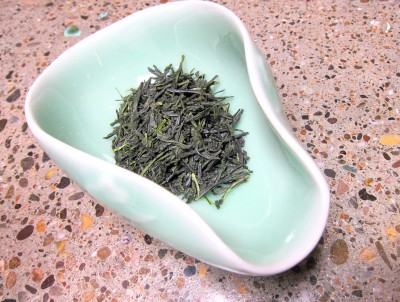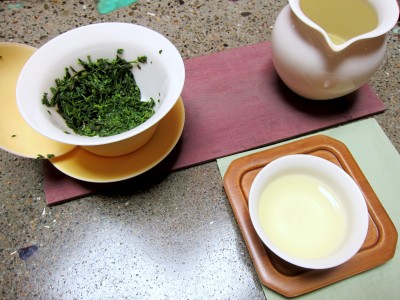
“Shincha” means “new tea”. It’s popular in Japan, but outside of the Japan, it’s the kind of “insider tea” that only a regular would know because the host whispers to her “hey we just got a small bag arrive in the back”. When I tell people that I’d like some “shincha”, they would ask me “You mean ‘sencha’?”. No, I mean shincha. They sound similar, and they ARE similar if the sencha is of very high grade, but even then, any tea drinker would be able to discern the two both in appearance and in taste.
The first time I had shincha was with Yuri. She’s the regular that the host whispered to, and I was lucky enough that she shared with me a few cups. Yuri explained how shincha is sweeter and lighter than sencha because shincha is the earliest harvest of sencha in a year’s time, when the leaves are new and tender. Teas leftover from the previous year are known as “kocha”. Appearance-wise, shincha has a brighter, younger green than sencha, although both come in small needle-like shape before steeping, shincha looks fatter (I guess because they have some buds, whereas sencha is just leaves).
The second time, I was by myself. I asked Masood for a pot of shincha, and for 2 seconds he looked at me like I came from Mars. I enjoyed those 2 seconds. Knowing something that Teance has in the back room when a Teance employer doesn’t know about, it made me feel secretive, and like every normal person, I like secrets. So anyway, Masood checked with Cheryl, who is the host that told Yuri about the shincha, and Cheryl confirmed that I didn’t come from Mars and brought out the tiny 1 oz bag. We proceeded to steeping. None of us had done it before.
Because it’s similar to sencha, we expected a similar steeping procedure. Sencha is a no-rinse, top-down steep (fill the gaiwan with warm water, then add the leaves – as opposed to add the leaves, then add water as you would with every other tea). So we did the same thing with shincha. First, we let the water cool from 175 degree Fahrenheit (~ 79 degree Celsius) to 160 F (~ 71 C). We didn’t use a thermometer, we just looked at the steam rising from the water: we want a slow, thin, slightly curly steam, like the smoke from a burning cigarette left alone on the ashtray.
 The steeping time is tricky. For a teaspoon of leaf in a small gaiwan, 10 seconds yielded flavored water, but 20 seconds made it too bitter (compared to how sweet it should be). A good judge is the color: it should be the bright yellowish green of a 3-week-old onion sprout. For this tea, greenish yellow (like in the picture to the right) means oversteeping. I’ll admit, it’s ridiculous to even try to describe these things in words, when you look at the colors they’re about as different as “cream” and “lemon chiffon” on this Wikipedia page, with a hint of green. It’s like trying to distinguish cerulean from blue when you’re Anne Hathaway playing Andrea Sachs in The Devil Wears Prada. But when you’ve steeped enough teas like Masood, you become Meryl Streeps. You just know when it’s right.
The steeping time is tricky. For a teaspoon of leaf in a small gaiwan, 10 seconds yielded flavored water, but 20 seconds made it too bitter (compared to how sweet it should be). A good judge is the color: it should be the bright yellowish green of a 3-week-old onion sprout. For this tea, greenish yellow (like in the picture to the right) means oversteeping. I’ll admit, it’s ridiculous to even try to describe these things in words, when you look at the colors they’re about as different as “cream” and “lemon chiffon” on this Wikipedia page, with a hint of green. It’s like trying to distinguish cerulean from blue when you’re Anne Hathaway playing Andrea Sachs in The Devil Wears Prada. But when you’ve steeped enough teas like Masood, you become Meryl Streeps. You just know when it’s right.